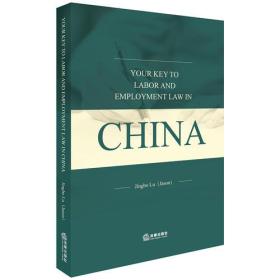
中国劳动用工法律精要
正版保障 假一赔十 可开发票
¥ 49.62 7.3折 ¥ 68 全新
库存3件
作者陆敬波 著
出版社法律出版社
ISBN9787519716424
出版时间2017-11
装帧平装
开本16开
定价68元
货号25197724
上书时间2024-10-28
- 最新上架
商品详情
- 品相描述:全新
- 商品描述
-
导语摘要
《Your Key to Labor and Employment Law in China》adopting the structure of the Labor Law as a basis and written with a global vision, this book is conceptualized as the first practical book introducing China,s labor and employment law and initially establishes the general rules governing the employment relationship and integrating the experience of River Delta Law Firm,s native lawyers. It provides an overview of the China,s labor and employment law which is useful for foreign enterprises operating in China or who deal with Chinese companies. It is also useful for foreigners seeking a basic understanding of China,s labor and employment law. Additionally, we trust that the book is useful for comparative study by human resources professionals working in multi-national enterprises and international labor law experts.
本书是一本关于中国劳动法与中国劳动合同法的实用手册。全面涵盖了中国劳动法领域的所有核心及实务问题,包括劳动合同、劳动报酬(工资)、劳动时间与休息休假、劳动安全与健康、女职工的劳动保护、外国人劳动者、社保与住房公积金、集体合同、工会与民主管理、劳动行政管理部门的监管、劳务纠纷。内容采用"总-分"的结构形式,是劳动法律师、外企高管、法务、人力资源管理者及所有对中国劳动法感兴趣的外国学者、研究人员的重要、实用、便捷的参考资料。
作者简介Jingbo Lu (Jason),the Founding Partner and Director of River Delta Law Firm, is a renowned labor and employment law expert in China. Jingbo Lu was, and continues to be, a forerunner and pioneer in the labor and employment law service area for the Mainland of China.
Having practiced for over 20 years, Jingbo Lu has many notable accomplishments ,including founding the first professional online labor law service platform www.laodongfa.com,initiating the first HR periodical "Labor Law China" ,and launching the first app" Labor Law China "for HR services. Jingbo Lu has also acted as a long-term legal consultant for hundreds of multinational corporations, foreign-funded enterprises, state-owned enterprises and private enterprises .He has also provided training of labor and employment law in the Mainland of China, Hong Kong, Singapore, Vietnam, US California and Cambodia for thousands of enterprises over his many years of practice. Jingbo Lu's outstanding performance in labor law has earned him a strong reputation among his peers, and it has solidified his position as a leading expert in the area of labor and employment law throughout the Mainland of China.
Jingbo Lu's most notable publications include:
◆RDL-Golden Key to Employment Law-Management of Employment Termination
◆RDL-Golden Key to Employment Law-Management of Female Employees
◆A Guide to HR Application of Employment Contract Law
◆Dispute and Harmony-Essentials on Labor Dispute Prevention and Settlement
◆Legal Practice for Enterprise Recruitment Management
◆Management of Employment Relationship of Group Enterprises
目录Chapter 1Overview
1.1Brief History of Chinas Labor and Employment Law
1.1.1Prehistory of Chinas Labor and Employment Law
1.1.2Labor and Employment Law in the Modern China
1.1.3Labor and Employment Law during the Transition Period of the New PRC
1.1.4Labor and Employment Law toward the Contemporary China
1.2Framework of Chinas Labor and Employment Law System
1.2.1Levels of Chinas Labor and Employment Law
1.2.2Sections of Chinas Labor and Employment Law
1.3Main Features of Chinas Labor and Employment Law System
1.3.1Close Connection with the Politics
1.3.2Enormous, Diversified and Convoluted Contents
1.3.3Increasingly Important Local Judicial Documents and Typical Cases
Chapter 2Employment Contract
2.1Introduction
2.2Employer and Employee
2.2.1Scope of Employer
2.2.2Identification of Employer
2.2.3Qualifications for Employee
2.3Identification of Employment Relationship
2.3.1Characteristics of Employment Relationship
2.3.2Evidences for Employment Relationship
2.3.3How to Identify an Employment Relationship
2.4Work Rules and Regulations of Employer
2.4.1Nature of Work Rules
2.4.2Two Types of Work Rules
2.4.3Legality of Contents of Work Rules
2.4.4Procedures of Formulation and Modification of Work Rules
2.4.5Relation between Work Rules and Employment Contract
2.5Establishment of Employment Contract
2.5.1Right to Know of both Parties
2.5.2Requirements for Written Form
2.5.3De facto Employment Relationship
2.5.4Required Clauses of Employment Contract
2.5.5Three Types of Employment Contract
2.6Open Ended Employment Contract
2.6.1Circumstances under which an Open Ended Employment Contract must be Established
2.6.210 Consecutive Years of Service with the Same Employer
2.6.3Two Consecutive Fixed Term Employment Contract with the Same Employer
2.6.4Legal Liability for Failing to Establish an Open Ended Employment Contract
2.6.5How to Establish an Open Ended Employment Contract
2.7Probation Period
2.7.1Application of Probation Period
2.7.2Times of Probation Period
2.7.3Length of Probation Period
2.7.4Suspension of Probation Period
2.7.5Wage during Probation Period
2.7.6Resignation and Dismissal during Probation Period
2.8Term of Service
2.8.1Conditions for Setting a Term of Service
2.8.2Breach of Term of Service
2.8.3Liquidated Damages
2.8.4Relation between Term of Service and Term of Employment Contract
2.9Non Competition Agreement
2.9.1Employees Suitable for Non Competition Agreement
2.9.2The Scope, Term and Area of Non Competition
2.9.3Economic Compensation for Non Competition
2.9.4Dissolution of Non Competition Agreement
2.9.5Responsibility for Breach of Agreement
2.10Invalidity of Employment Contract
2.10.1Three Circumstances causing Invalidity
2.10.2Ways to Determine Invalidity
2.10.3Legal Consequences of Invalidity
2.11Performance and Modification of Employment Contract
2.11.1Full Performance of Employment Contract
2.11.2Merger and Separation of Employer and Change of Employers Name, Legal Representative, Key Person in Charge and Investors
2.11.3Identification of Modification of Employment Contract
2.11.4How to Modify an Employment Contract
2.12Dissolution of Employment Contract by Employee
2.12.1Distinction between Dissolution and Termination of Employment Contract
2.12.2Two Types of Dissolution by Employee
2.12.3Immediate Dissolution by Employee
2.12.4AdvanceNotice of Dissolution by Employee
2.12.5Liabilities for Unlawful Dissolution by Employee
2.13Immediate Dissolution of Employment Contract by Employer
2.13.1Three Types of Dissolution of Employment Contract by Employer
2.13.2Circumstances for Immediate Dissolution by Employer
2.13.3Procedures of Immediate Dissolution by Employer
2.13.4Nature of Immediate Dissolution by Employer
2.14Advance Notice Dissolution of Employment Contract by Employer
2.14.1Circumstances for Advance Notice Dissolution by Employer
2.14.2Procedures of Advance Notice Dissolution by Employer
2.14.3Exceptions to Advance Notice Dissolution by Employer
2.15Economic Lay off by Employer
2.15.1Circumstances for Lay off by Employer
2.15.2Conditions for Lay off by Employer
2.15.3Procedures of Lay off by Employer
2.15.4Protections in Lay off by Employer
2.16Dissolution of Employment Contract by Mutual Agreement
2.16.1Two Types of Dissolution of Employment Contract by Mutual Agreement
2.16.2Application Scope of Dissolution by Mutual Agreement
2.16.3Requirements on Dissolution by Mutual Agreement
2.17Termination of Employment Contract
2.17.1Circumstances for Termination of Employment Contract
2.17.2Exceptions to Termination of Employment Contract
2.17.3Terminations with Severance Pay
2.18Collateral Obligations for Dissolution and Termination of Employment Contract
2.18.1Certificate of Dissolution or Termination of Employment Contract
2.18.2Transfer of Employees Archives and Social Insurance Relationship
2.18.3Handover of Work
2.19Severance Pay
2.19.1Scope of Application of Severance Pay
2.19.2General Standard of Severance Pay
2.19.3Special Standard of Severance Pay
2.19.4Payment of Severance Pay
2.20Unlawful Dissolution and Termination of Employment Contract
2.20.1Identification of Unlawful Dissolution or Termination of Employment Contract
2.20.2Remedy for Unlawful Dissolution or Termination
2.21Labor Dispatch
2.21.1Labor Dispatch vs. Outsourcing
2.21.2Requirements for Establishment of Dispatching Entity
2.21.3Scope of Application of Labor Dispatch
2.21.4Employment Contract and Dispatch Agreement
2.21.5Employment Relationship between Dispatched Employee and Accepting Entity
2.21.6Return of Dispatched Employee
2.22Part Time Employment
2.22.1Definition of Part Time Employment
2.22.2Establishment of Part Time Employment Contract
2.22.3Payment for Part Time Employee
2.22.4Termination of Part Time Employment
Chapter 3Wage
3.1Introduction
3.2Definition of Wage
3.2.1Nature of Wage
3.2.2Basic Principles of Wage Legislation
3.2.3Components of Wage
3.3Minimum Wage and Social Average Wage
3.3.1Definition of Minimum Wage
3.3.2Income Excluded from the Minimum Wage
3.3.3Determination of Minimum Wage
3.3.4Standard of Minimum Wage and Social Average Wage
3.4Overtime Wage
3.4.1Cardinal Number for Calculation of Overtime Wage
3.4.2Rates for Calculation of Overtime Wage
3.5Determination and Adjustment of Wage
3.5.1Determination of Wage
3.5.2Adjustment of Wage
3.5.3Wages during Downtime and Idling Period
3.6Payment of Wage
3.6.1Payment with Legal Tender
3.6.2Payment Directly to the Employee and Obligation of Recording
3.6.3Payment in Time and Postponement of Payment
3.
相关推荐
— 没有更多了 —




















以下为对购买帮助不大的评价